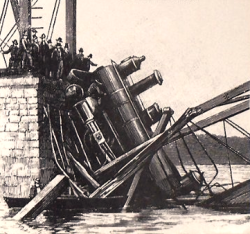cwharpe
About
- Username
- cwharpe
- Joined
- Visits
- 933
- Last Active
- Roles
- Member
Comments
-
You might also try an adjusted Traction pressure equation. This approach costs no further work when changing resolution. Say you have a simple ramp load function (ax+b) in the -z direction, with x as the beam length axis. [Or, if the first beam nod…
-
Crafty external editing hack. Seems I can't avoid scripting in one form or another. I'll give it a try. By the way, some very nice improvements in release 14. Some of my favorites: * Outline Tree doesn't scroll after edit & stays put (Th…
-
File below.
-
Yes, I think the classical solution produced by Roark neglects stress concentration at the fixed support. Your suggestion led me to create a rigid "picture frame" surrounding the plate, which I made rigid by increasing the Modulus by 4-6 orders o…
-
The ASME B30.20-2018 Standard refers to two classes of testing -- Operational Tests & Load Tests. Operational is qualitative -- clasps close, arms rotate, switches throw, etc. These things are mandatory. Whether to Load Test (typically 125% o…
-
What also works to retain the top-edge shape is to increase the stiffness of your spider beams, whether by bumping the spider's Young's Modulus up by, say, x1000, or by increasing the spider cross-sectional inertia by a similar magnitude. I seem to…
-
@Victor, If the named load groups (folders) is still in the works for ver. 14, I'm wondering if the needle has moved yet for adding a multiplier (Co-Factor) outside of the group? This multiplier would apply to all the loads within the group, and w…
-
Thanks for the reassurance. I was half a minute away from a clean re-install to chase out the gremlins. Also, had never expressly loaded an .frd file to check results. Until now. Nice workaround.
-
[A belated Thanks to everyone who contributed an answer. Clearly, modeling a bolt with solids gives a superior result. Seems I learn more when things go wrong -- I'd never heard of hour-glassing before this.] Lately I've been trying to verify the…
-
I actually have the same question. So, I'm next in line after DCH. Hoping to simulate the bolt spiders using node-surface coupling and inducing preload by node displacement. Preload by constraint equation would be nice, but it's not available in …
-
Thanks! This helps me begin at least within the ballpark of the successful solution.
-
Thanks for the reassurance. Regarding initial Contact Stiffness (C.S.) between two dissimilar materials, say E1=30e6 psi, E2=10e6 psi. Let E1 material be 2" tall, 3" wide, 4" long, and E2 material be 1" tall, 2" wide, 3" long. Using your formula …
-
I made Victor's constraint adjustment, set the time step to .01 s and reproduced the plot (Cheers). Another point of the exercise was to see how close to theory the results came. For quick comparison, I am using the calculator found here: https://a…
-
@Victor Is it possible to peek at your Analysis Settings window on your Non-Linear Static 3D solution. I've input your suggested values but I'm not getting the expected solution. My time step graphs are do not look smooth like yours, and when I d…
-
@JohnM I'm a total newbie with the CCX side. Couldn't get your example to work. CCX solver says "cannot open file MY_AMPLITUDES.INP". Maybe I've got the file in the wrong place??
-
prop_design By Folders, I meant all the dead loads under a Tab called DL, all the live loads under a Tab called LL, etc. With amplification factor, say "a", attached to each Tab (default=1), then turning Tab OFF is a=0. Making a Load Combination…
-
The configurations feature is VERY helpful. But the setup requires sorting through individual forces (a list of qty. 140 for treehouse), turning the proper ones off or back on, editing the right forces to reflect the correct multiplier (e.g. 0.75*L…
-
Thanks for the suggestions. Using the springs worked well. Was able to play with spring rate and "Pressure Plate" thickness until solution converged within 3 significant digits. Frame displacements measured at same node were definitely sensitive …
-
Update: CSV File written in the same directory as the current Mecway model. Was looking in the wrong place. Still wouldn't mind an on-screen summary, though.

